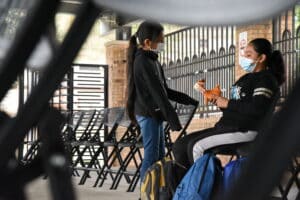BROWNSVILLE — Five migrant families released from federal custody Wednesday morning waited for their bus in an outdoor area set up at the Brownsville bus station near the U.S.-Mexico border.

(Valerie Gonzalez | [email protected])
Until last Wednesday, the practice of releasing migrant families into the U.S. with a notice to appear in an immigration court at a later date was halted first by the Migrant Protection Protocols in 2019 and more broadly later by the pandemic — with a few exceptions in the form of released pregnant migrants.
Asylum-seeking families are currently released from federal custody to Brownsville and McAllen in the Rio Grande Valley area.
Unlike the thousands who wait on the Mexican side of the U.S. border under the Migrant Protection Protocols, where they are forced to wait until their immigration court hearing in the U.S., those who are released currently are not part of the program.
All five families who spoke to The Monitor arrived only days ago from Central American countries to the Texas-Tamaulipas border. Each were released on their own recognizance with a notice to appear at an immigration court on a date to be determined later.
The largest CBP processing center in McAllen, which held over 1,000 people at a time, is no longer open until renovations are completed later in the year.
Overall holding capacity in the Rio Grande Valley was further affected by pandemic restrictions. Processing space will soon increase when a large tent structure is opened in Donna later this month.

(Valerie Gonzalez | [email protected])
“CBP has seen a steady increase in border encounters since April 2020, which, aggravated by COVID-19 restrictions and social distancing guidelines, has caused some facilities to reach maximum, safe holding capacity,” a CBP statement read. “As is always the case, persons taken into custody and processed under Title 8 are evaluated on a case-by-case basis for consideration of a custody redetermination pending an immigration hearing. Whenever feasible we are seeking alternatives to detention in cases where the law allows.
For those released, CBP may work with non-government organizations who will assist them through the out-of-custody process.”
CITIES AND NONPROFITS FORM LOCAL RESPONSE
About 50 to 80 people are released on a daily basis to the Catholic Charities Humanitarian Respite Center in McAllen, Sister Norma Pimentel, the executive director, said Wednesday.
In Brownsville, up to 50 people will be dropped off throughout the day and during the weekend, a city employee estimated.
The city of Brownsville is devoting two city employees to help man the drop off and waiting area at the bus station. Migrants are dropped off by federal officers where upon arriving they share their U.S. relatives’ contact information. An employee will help coordinate the purchase of a plane or bus ticket.

(Valerie Gonzalez | [email protected])
Brownsville is devoting resources as they did in 2019, though the surge at the time required greater planning and manpower. That year, the city spent $399,704 by providing transportation and security to migrants moving from shelters to bus stations and airports.
In the end, the city was nearly completely reimbursed, receiving $394,453.04 back from the federal government.
On Tuesday, Mayor Trey Mendez was part of a meeting, which he called a “listening session,” with a federal government intergovernmental affairs representative.
“I gave them the perspective of our community and what it’s like to actually be handling this,” Mendez said.
“Obviously, it’s something that is costing us time and resources. But we also see it as something necessary to support the federal government right now. We’ll seek to see if we can get some type of reimbursement in the future, but at this point in time there’s no promises of reimbursements that I’m aware of.”
The city of McAllen is not currently providing manpower to the asylum efforts but they are monitoring the flow, McAllen City Manager Roel “Roy” Rodriguez said Wednesday evening.

(Valerie Gonzalez | [email protected])
In the last 10 days he said they’ve had four conference calls with CBP, U.S. Border Patrol, and Cathlolic Charities of the Rio Grande Valley.
“We could expect another influx as we did four or five years ago,” Rodriguez said, adding, “Our concern, obviously, isn’t the immigrants themselves, because we’ve already shown we can handle that. Our concern is COVID.”
“We were told by our federal partners that some 300 apprehensions took place last week, and we’re not seeing them at the Respite Center or the bus station. So they’re somewhere else. That’s part of the equation we are dealing with,” he said.
As of this morning, Rodriguez said there were 80 immigrants at the respite center. The number increased significantly from the prior average of 20, he said.
“Eighty isn’t a lot of people,” he added. “We can handle that. We can’t handle 500 or 600 because of COVID, so that’s what we’ve seen so far.”
The U.S. Border Patrol is currently only testing immigrants who are symptomatic. The rest are not tested before release.
Rodriguez said the city reached out last week to the governor’s office and the Texas Division of Emergency Management and immediately received 6,000 COVID-19 rapid test kits. Those were shared with Catholic Charities of the Rio Grande Valley.
Families at the Brownsville station Thursday said they were all tested for COVID-19, though by whom remains unclear. Team Brownsville’s co-founder Sergio Cordova said the city is no longer administering COVID-19 tests. As of Sunday, the migrants were moved from the indoor area of the bus station to an outdoor space.
Travelers who need to stay the night are assisted by the Ozanam Center in Brownsville. Victor Maldonado, the shelter director, said they’ve received about 30 families since the releases began last week.
Throughout the day, volunteers with Team Brownsville, Good Neighbor Settlement House and Church of the Nazarene will take meals to the bus station.
Pastor Mark Redwine of Church of Nazarene who is also part of Team Brownsville, showed up on Thursday. He says Team Brownsville helps supply food on the weekend but also provides a variety of assistance throughout the week.
“Team Brownsville has set up sanitation for this end of our operation, hand washing stations and they’ve got some porta potties,” Redwine said. “And, they make sure that travelers have all their needs met. They’ve got snack bags. They’ve got things for the kids. They’re able to show them the bus routes and where they’re going to go.”
FAMILIES FEEL HOPEFUL
Families released Thursday said they were processed quickly and reported good treatment from Border Patrol agents who offered them water, juice for their children, medical attention, and even the opportunity to call relatives who could receive them in the U.S.
A Guatemalan mother, Maria Ramirez, 27, her 10 year-old daughter and 7 year-old son waited patiently for their bus in Brownsville.
Ramirez made a difficult decision when she came to the U.S. and left her youngest behind. A decision Ramirez’s mother made 14 years ago.

(Valerie Gonzalez | [email protected])
“Since she left us,” Ramirez said referring to her mother, “we separated from her just like I separated from my youngest daughter. I left her in Guatemala, because I couldn’t bring three, just two,” she said with eyes brimming with tears.
She watched the U.S. news of the country years before leaving. During the last four years, she felt scared off from the country where she sought to reunite with her mother and seek out the “American dream” for her children.
“We don’t come to invade or come to hurt anyone, simply to look for a better future for our children. That’s all,” she said.
Monitor staff writer Naxiely Lopez-Puente contributed to this story.




